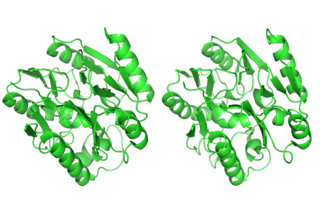
The organic compound citrulline is an α-amino acid. Its name is derived from citrullus, the Latin word for watermelon. Although named and described by gastroenterologists since the late 19th century, it was first isolated from watermelon in 1914 by Japanese researchers Yotaro Koga and Ryo Odake and further codified by Mitsunori Wada of Tokyo Imperial University in 1930. It has the formula H2NC(O)NH(CH2)3CH(NH2)CO2H. It is a key intermediate in the urea cycle, the pathway by which mammals excrete ammonia by converting it into urea. Citrulline is also produced as a byproduct of the enzymatic production of nitric oxide from the amino acid arginine, catalyzed by nitric oxide synthase.

Nitric oxide synthases (NOSs) are a family of enzymes catalyzing the production of nitric oxide (NO) from L-arginine. NO is an important cellular signaling molecule. It helps modulate vascular tone, insulin secretion, airway tone, and peristalsis, and is involved in angiogenesis and neural development. It may function as a retrograde neurotransmitter. Nitric oxide is mediated in mammals by the calcium-calmodulin controlled isoenzymes eNOS and nNOS. The inducible isoform, iNOS, involved in immune response, binds calmodulin at physiologically relevant concentrations, and produces NO as an immune defense mechanism, as NO is a free radical with an unpaired electron. It is the proximate cause of septic shock and may function in autoimmune disease.

Argininosuccinate synthase or synthetase is an enzyme that catalyzes the synthesis of argininosuccinate from citrulline and aspartate. In humans, argininosuccinate synthase is encoded by the ASS gene located on chromosome 9.
In enzymology, an alkene monooxygenase (EC 1.14.13.69) is an enzyme that catalyzes the chemical reaction

Nitric oxide dioxygenase (EC 1.14.12.17) is an enzyme that catalyzes the conversion of nitric oxide (NO) to nitrate (NO−
3) . The net reaction for the reaction catalyzed by nitric oxide dioxygenase is shown below:

In enzymology, a NAD+ synthase (glutamine-hydrolysing) (EC 6.3.5.1) is an enzyme that catalyzes the chemical reaction
In enzymology, an arginine deiminase (EC 3.5.3.6) is an enzyme that catalyzes the chemical reaction

In the field of enzymology, a dimethylargininase, also known as a dimethylarginine dimethylaminohydrolase (DDAH), is an enzyme that catalyzes the chemical reaction:
Nitric oxide reductase (NAD(P), nitrous oxide-forming) (EC 1.7.1.14, fungal nitric oxide reductase, cytochrome P450nor, NOR (ambiguous)) is an enzyme with systematic name nitrous oxide:NAD(P) oxidoreductase. This enzyme catalyses the following chemical reaction
Tyrosine N-monooxygenase (EC 1.14.13.41, tyrosine N-hydroxylase, CYP79A1) is an enzyme with systematic name L-tyrosine,NADPH:oxygen oxidoreductase (N-hydroxylating). This enzyme catalyses the following chemical reaction
Methylsterol monooxygenase (EC 1.14.13.72, methylsterol hydroxylase, 4-methylsterol oxidase, 4,4-dimethyl-5alpha-cholest-7-en-3beta-ol,hydrogen-donor:oxygen oxidoreductase (hydroxylating)) is an enzyme with systematic name 4,4-dimethyl-5alpha-cholest-7-en-3beta-ol,NAD(P)H:oxygen oxidoreductase (hydroxylating). This enzyme catalyses the following chemical reaction
Zeaxanthin epoxidase (EC 1.14.13.90, Zea-epoxidase) is an enzyme with systematic name zeaxanthin,NAD(P)H:oxygen oxidoreductase. This enzyme catalyses the following chemical reaction
Isoleucine N-monooxygenase (EC 1.14.13.117, CYP79D3, CYP79D4) is an enzyme with systematic name L-isoleucine,NADPH:oxygen oxidoreductase (N-hydroxylating). This enzyme catalyses the following chemical reaction
Valine N-monooxygenase (EC 1.14.13.118, CYP79D1, CYP79D2) is an enzyme with systematic name L-valine,NADPH:oxygen oxidoreductase (N-hydroxylating). This enzyme catalyses the following chemical reaction
Phenylalanine N-monooxygenase (EC 1.14.14.40, phenylalanine N-hydroxylase, CYP79A2) is an enzyme with systematic name L-phenylalanine,NADPH:oxygen oxidoreductase (N-hydroxylating). This enzyme catalyses the following chemical reaction
Tryptophan N-monooxygenase (EC 1.14.13.125, tryptophan N-hydroxylase, CYP79B1, CYP79B2, CYP79B3) is an enzyme with systematic name L-tryptophan,NADPH:oxygen oxidoreductase (N-hydroxylating). This enzyme catalyses the following chemical reaction
Beta-carotene 3-hydroxylase (EC 1.14.13.129, beta-carotene 3,3'-monooxygenase, CrtZ) is an enzyme with systematic name beta-carotene,NADH:oxygen 3-oxidoreductase . This enzyme catalyses the following chemical reaction
6-hydroxy-3-succinoylpyridine 3-monooxygenase (EC 1.14.13.163, 6-hydroxy-3-succinoylpyridine hydroxylase, hspA (gene), hspB (gene)) is an enzyme with systematic name 4-(6-hydroxypyridin-3-yl)-4-oxobutanoate,NADH:oxygen oxidoreductase (3-hydroxylating, succinate semialdehyde releasing). This enzyme catalyses the following chemical reaction
Biflaviolin synthase (EC 1.14.21.7, CYP158A2, CYP 158A2, cytochrome P450 158A2) is an enzyme with systematic name flaviolin,NADPH:oxygen oxidoreductase. This enzyme catalyses the following chemical reaction

L-ornithine N5 monooxygenase (EC 1.14.13.195 or EC 1.14.13.196) is an enzyme which catalyzes one of the following chemical reactions:
L-ornithine + NADPH + O2 N(5)-hydroxy-L-ornithine + NADP+ + H2O L-ornithine + NAD(P)H + O2 N(5)-hydroxy-L-ornithine + NAD(P)+ + H2O







